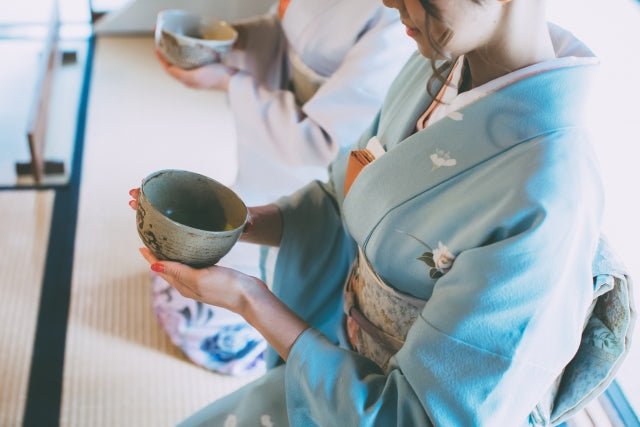これは、現在フランスを拠点に活動する、お茶愛好家であり、歴史を趣味とするジミー・バーリッジによる書評と解説です。ぜひお楽しみください!
この記事では、茶道を実践した人々、茶道が何を意味し、何世紀にもわたってどのような社会的・文化的役割を果たしてきたかを考察した2冊の書籍について解説します。それぞれのタイトルは以下の通りです。
『お茶を淹れて日本をつくる:文化ナショナリズムの実践』クリスティン・スラック著、2013年、スタンフォード大学出版局。
『女性らしさを育む:江戸・明治期の日本における女性と茶文化』レベッカ・コーベット著。2018年。ハワイ大学出版局。
レビュー
ほとんどの日本人、そして外国人の中にも、茶道(茶の湯)は封建時代の領主や侍が関わる、漠然としたイメージを持っている人は少なくありません。彼らは刀を脇に置き、念入りに練られた儀式のために着席する姿を想像するかもしれません。あるいは、茶道は富を誇示するための背景として、また社交の場として、さらには政治的な役割も担っていたというイメージを持っているかもしれません。しかし、現代では状況は大きく異なり、侍は存在せず、ほとんど誰でも茶の湯を体験できることは知っています。しかし同時に、茶道には依然として高度な形式と伝統が残っており、茶道が本質的に日本的な何かを体現していることも知っています。お茶を淹れる特別な方法があったことは想像できるでしょうが、結局のところ、ほとんどの人は茶道そのもの、誰が参加したのか、茶道がどのような意味を持ち、どのような目的で行われてきたのかについては、ほとんど知りません。ここで取り上げる2冊の本は、150年以上前の資料、インタビュー、そして個人の経験に基づいてこれらの疑問を探求し、茶道の歴史的、そして現代的な意義について、より繊細な視点を提供しています。
どちらの本も外国人女性によって書かれていますが、著者はいずれも日本文化や茶道に精通しています。お茶の基礎をすでに知っている読者を対象とした学術的な研究書であるにもかかわらず、私は親しみやすく、よく書かれ、非常に読みやすいと感じました。私はむしろ、その形式的で厳密なアプローチを高く評価しています。しかしながら、これらは寝る前に時々手に取るような軽い読み物ではありません!私がこの本から得た主なメッセージは、茶の湯は歴史的ルーツを持つ、高度に体系化された参加型の儀式以上のものだということです。私は、茶の湯がそのダイナミックな歴史の中で多様な役割を果たし、個人的、社会的、そして国家的な領域にまたがる多層的な意義を持っていることを学びました。これらの本は、千利休や村田珠光に関する基本的な物語を繰り返す、有名人の聖人伝になりがちなものよりもはるかに深いところまで掘り下げています。むしろ、利休と同時期および利休後に何が起こっていたのかを探り、時代を超えた社会的、文化的潮流を概観しています。私はこれらの本を強く推薦し、何世紀にもわたって茶道が何を意味し、誰が茶道を実践し、どのような目的で茶の湯を実践してきたかを深く探求することを奨励します。
要約と解説
レベッカ・コーベット著『Cultivating Femininity(女性らしさを育む)』の中で、著者は主に江戸時代と明治時代の日本における茶道における女性の役割を比較しています。江戸時代(1600~1868年)は明治時代の直前にあたります。明治時代の改革は日本の近代化と、世界的に重要な国民国家の台頭につながりました。江戸時代は、多くの人が想像する封建時代(1185~1600年)の後に続き、武士や大名(地方領主)が存在し、茶道の「古典的」な側面が体系化されました。ちなみに、日本の茶道に最も影響を与えたと多くの人が考える千利休は、 1591年に亡くなりました。
レベッカ・コーベットは、江戸時代に茶道が二つの異なる領域に分かれていたことを指摘する。正式な領域は、千利休のようなエリート政治家、武士、そしてその朝廷関係者で構成されていた。今日の文献の大部分はこの正式な領域を扱っており、特に影響力があったとされる、男性が主導する比較的少数の茶会に焦点を当てている。しかし、この領域においても、歴史的記録や書簡は、女性、特に茶人や武士の妻が、主に夫が留守の時ではあったものの、重要な茶会を執り行っていたことを示している。とはいえ、女性は夫だけでなく、茶会で何か失敗があれば大名の恥辱を受けることになる知識、経験、そして夫からの信頼も得ていた。この領域における女性の重要な役割は、今日ではほとんど認識されていない。
茶道のもう一つの、より形式にとらわれない領域、つまり茶会の大半がそこで行われていたであろう領域においても、女性は重要な役割を果たしていました。著者は、この形式にとらわれない領域こそが、新しいアイデア、手順、そして美的要素が実験される場であり、女性は単なる客人としてではなく、重要な役割を担っていたと示唆しています。レベッカ・コーベットは、歴史的記録、出版物、さらには古い演劇作品を用いて、明治以前の茶道の歴史における女性の活躍を紐解きます。茶会の記録簿は、使用された道具、展示された芸術的要素、誰が出席し、誰が茶を注いだかなど、あらゆる詳細が記載されているため、特に貴重です。
特に興味深いのは、人形劇『槍の権三(やりのごんざ)かたびら』(1717年)の物語である。この物語では、茶人の妻であるお斎が茶道に関して重大な責任と知識を担っており、その中には通常、茶人の息子にしか与えられない秘密の知識も含まれている。お斎は娘に、地元の大名のために重要かつ珍しい種類の茶を点てることができるほどの奥義を教えた。こうした大衆文化の側面から、女性も茶道の実践や公演に関わっていたにもかかわらず、その貢献、創造性、茶道の維持に対して女性ほどの評価を受けていなかったことがわかる。
『女性らしさの涵養』と『茶の湯、日本を作る』はどちらも、変革期の明治時代における茶道と女性の関係を綿密に検証しています。江戸時代の日本では、茶道は主にエリート層、あるいはエリートと関わりのある遊女によって行われていました。明治維新の革命的な改革により、茶道は新しい層に開かれました。急速な産業化によって、以前の貴族階級とはつながりのない、しかし新しいエリート層の洗練された一員としての地位を確立することに関心を持つ新しいビジネスクラスが生まれました。茶道を実践し、主催することは、幅広い専門知識、洗練された芸術的センス、そして本物の日本の価値観を示す手段でした。茶道を実践することは、日本の伝統文化に足場を保つだけでなく、「文明開化」を特徴とする近代世界で活動する方法にもなりました。
この時代には多くの根本的な変化がありました。日本列島は単一の中央政府の下に統一され、交通と産業は都市部と農村部の両方の特性を変え、社会組織と文化的規範は移行しました。別のレベルでは、政治や知識人の影響力のある人々は、国をまとめ、国民的アイデンティティを創出し、日本が国際的に理解されるための枠組みを模索していました。1906年に出版された岡倉嘉穂による非常に影響力のある著書『茶の本』は、茶の湯を日本の文化と美学の典型的な表現と定義するのに大きく貢献しました。この独創的な著書は、日本と海外の両方で茶の湯に対する一般的な認識に影響を与えました。この頃には、茶の湯は国民的アイデンティティの最も簡潔で優れた表現、さらには一種の国のシンボルと見なされるようになりました。
著者らは、女学校の一次資料、大衆雑誌やガイドブック、そして明治時代の学術文献を検証し、茶道がどのように適切な価値観と立ち居振る舞いを教えるために用いられていたかを明らかにしている。若い女性に適切な日本の感性、価値観、そして礼儀作法をどのように教えるかという議論は、公共の場で頻繁に行われ、茶道を学ぶことは効果的な方法論として広く認識されていた。少なくとも茶道の基本的要素は公立学校と私立学校の両方で教えられており、エリート女子校では茶道に多くの時間が割かれていた。茶の湯の厳密に規定された動作の中には、茶の湯以外の場面にも応用できる、しかし適切な日本人の立ち居振る舞いに不可欠な、洗練された作法を直接的に教えるものもある。例えば、箸の持ち方、使い方、置き方、茶道に付随する正式な食事における座り方や食事の仕方などである。着物の着方や動き方、立ち方、そして回るときの足の出し方を学ぶことは、礼儀正しく、敬意を払い、謙虚な若い女性になるための学習の一部と考えられていた。
より深いレベルでは、茶道を通して価値観や適切な立ち居振る舞いを学び、洗練された女性らしさを身につけることは、より大きな国家建設プロジェクトの基礎となると考えられていました。茶の湯は、明治時代の思想でよく使われた言葉である「良妻賢母」を目指す女性の一種の訓練として普及しました。茶道を学ぶことの重要性は、次のような当時の議論によって示されています。調和のとれたお茶の淹れ方を学ぶことは円満な家庭につながります。円満な家庭は新しい日本の基礎です。したがって、女性が茶道を学ぶことは重要な国家建設プロジェクトです。このように、女性は母親、主婦、そして国家を作るという三重の責任を負っていました。「お茶と女性らしさ、そして日本らしさが分かちがたく結びついた」と言えるのはこの時代でした。
クリスティン・スラックは著書『 Making Tea, Making Japan』で、現代の茶の習慣と茶道の現代の訓練について検証している。抹茶の点て方は誰でも習えるが、完全に認定され認められた実践者または教師であることは重要な社会的価値を持つ。茶道学校は正式に生徒を茶道を教え、訓練修了証書を授与し、正式な茶の世界を効果的に規制している。クリスティン・スラックは、家元制度と呼ばれる一部の茶道学校の厳格な階層構造を概説し、日常的な知識や資格は基本的にお金を払って取得できるが、より難解な部分は依然として排他的であると述べている。皮肉なことに、学校経済が主に女性の訓練と資格取得費用の支払いに依存しているにもかかわらず、最も影響力のある茶道学校の男性指導者が依然として茶道を定義し、支配しているのである。
クリスティン・スラックは、現代の男性と女性の茶道実践者の目標が異なるように見える点について論じ、男性は鑑識眼、知的・哲学的理解を重視しているのに対し、女性は「適切な立ち居振る舞い、礼儀作法、マナーを学ぶこと」に重点を置いているようだと述べています。現代の男性実践者は、茶道の武士道的・外交的ルーツを強調することが多いのに対し、女性は優雅さと季節にふさわしい美的感覚を重視します。現代の男性と女性による茶道の構想、指導、実践におけるこの顕著な対照は、茶道の驚くべき柔軟性を物語っています。
 現代日本の茶道の風景。画像提供: kikuo / PIXTA
現代日本の茶道の風景。画像提供: kikuo / PIXTA
結論
茶の湯を歴史的に見ると、そのダイナミズム、適応力、そして時代を超えた重要性が明らかになります。茶の湯は、何世紀にもわたって劇的に変化してきた側面もあれば、ほとんど変わらない側面もあります。おそらく、この安定と変化のパラドックスこそが、茶の湯が何世紀にもわたって社会生活と政治生活においてこれほど重要な位置を占めてきた理由なのでしょう。茶の湯は、国家運営のための政治的手段として、また非常に重要なステータスシンボルとして、国民的アイデンティティの構築に貢献し、近代化する日本におけるジェンダーの役割を教え、国際化する日本における独自の「日本らしさ」の概念を強化し、さらには国際的な聴衆に日本の美意識をアピールするためにも用いられてきました。茶の湯は、何世紀にもわたる社会、経済、政治の大きな変化の中で、その多義性を示し、今もなお重要な実践であり、試金石であり続けています。私たちは、茶の湯の未来、そして日本文化との関係について、疑問を抱いています。世界の継続的な変容の中で、茶の湯はどのように維持され、変化していくのでしょうか?茶文化は今後も日本のアイデンティティの中心であり続けるのでしょうか?もしそうなら、どのような形で?
 侘び寂びが多すぎる?フランス製の抹茶碗2点の不格好さは、茶道具を厳密に管理することに価値があることを示唆している。写真はジミー・バーリッジ。
侘び寂びが多すぎる?フランス製の抹茶碗2点の不格好さは、茶道具を厳密に管理することに価値があることを示唆している。写真はジミー・バーリッジ。
日本茶に関するその他の書籍:
Jimmy Burridge が書いた他の投稿もご覧ください:
注目画像のクレジット: acworks/Photo-AC。


